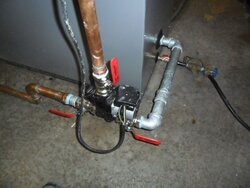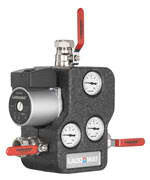I am trying to figure out what sort of circulator would be best....It will circulate from the boiler to storage and back, using a thermostatic valve.
Boiler is about 60 feet from storage. Lines are 1-1/2" pex. I calculate roughly 8 gpm and a ~10 foot head when the return from supply is at 140F (50f delta T) and roughly 20 gpm at a 24 foot head loss when the boiler is coasting down and the storage tank is nearly up to temperature (boiler output 50,000 btu/hr, delta T at 5F).
I understand that I need to choose a pump that will output 20 gpm at 24 feet of head, but what happens when I only need 8 gpm? Do I need a variable speed pump?
Thanks.
Boiler is about 60 feet from storage. Lines are 1-1/2" pex. I calculate roughly 8 gpm and a ~10 foot head when the return from supply is at 140F (50f delta T) and roughly 20 gpm at a 24 foot head loss when the boiler is coasting down and the storage tank is nearly up to temperature (boiler output 50,000 btu/hr, delta T at 5F).
I understand that I need to choose a pump that will output 20 gpm at 24 feet of head, but what happens when I only need 8 gpm? Do I need a variable speed pump?
Thanks.




